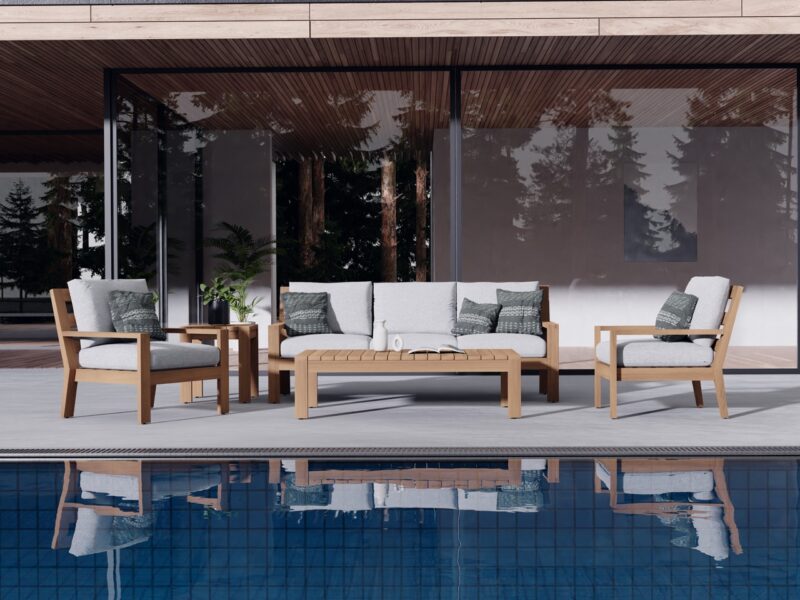With so many types of wood available, it can be challenging to identify between genuine teak and other similar-looking woods. Due to its strength and beauty, teak wood is a widely sought-after material for furniture, flooring, and outdoor decking. It is a well-liked material for both conventional and modern designs because of its warm, golden-brown color and distinctive grain patterns. So, it’s important for homeowners who wish to purchase teak wood furniture to be able to accurately identify the material from its characteristics. In order to make sure you’re receiving the real deal when buying teak products, we’ll go over the characteristics that set teak wood apart in this post as well as how to identify teak wood.
Table of Contents
The Importance of being able to identify
To be able to identify teak wood out of its characteristics and features is a must for anybody seeking premium furniture, for indoor or outdoor purposes. Without the ability to identify teak wood, you have the risk of buying a poor piece of product that won’t survive throughout the years or relish its aesthetic feature.
Being capable of identifying teak wood and recognizing its distinct characteristics is essential considering the cost you might face if you fail to identify them. In this post, we’ll examine the numerous qualities of teak wood that make it unique from other types of wood, empowering you to confidently select the ideal item for your requirements.
Characteristics of Teak Wood
While just a few types of wood are acknowledged for its characteristic on the global market for timbers, the renowned teak wood type remains in a culture of shifting tastes to be highly admired by buyers. Teak is frequently regarded as one of the most important types of wood in the world, and it continues to be popular due to its unique combination of mechanical and physical characteristics (Wood Assistant, n.d.). Looking at global patterns, there is no indication that any other type of tree will soon surpass teak, judged by its top-notch characteristics.
In this article, we shall examine the various characteristics of teak wood, such as its color, grain pattern, weight, and scent. By being aware of these characteristics and features, you can make sure you’re obtaining the real deal when selecting teak products to invest in a long-lasting material.
- Color
Although the color of the teak varies from species to species, the best teak will be golden-brown in color (Neighbor Editorial Team, 2021). The majority of people are familiar with teak wood in its stately tawny honey-golden color, but it initially has a bit of a dark and blotchy appearance. Teak wood’s color does vary slightly with time. Teak ultimately turns a silvery-gray tint as it ages (Vermont Woods Studios, n.d.).
- Grain
In this type of characteristic, teak has a straight grain with a sporadic interlocked or wavy grain (Wood Assistant, n.d.). It also has a coarse, uneven texture, and moderate to low natural luster. Raw, unfinished wood surfaces have a slightly oily or greasy feel due to natural oils (The Wood Database, n.d.).
- Weight
The genuine teak is quite dense and weighty. Its solid surface shouldn’t fracture or tear and will be sturdy (Neighbor Editorial Team, 2021). The average dried weight of teak wood is approximately 40.9 pounds per cubic foot, which is equivalent to 655 kilograms per cubic meter (The Wood Database, n.d.). This weight measurement is a crucial consideration when choosing teak wood for furniture because it is frequently used to evaluate the density and strength of the wood.
- Scent
When teak wood is cut, it emits a mild, leathery odor that is distinctive to this type of wood. This smell is often described as earthy, spicy, or even slightly sweet (Wood Assistant, n.d.), and can be a useful identifier for those who are familiar with working with teak wood. This odor is a notable characteristic of teak wood and can be a helpful clue in identifying this valuable and sought-after material.
Identifying Teak Wook vs. Other Woods
Teak wood can be difficult to identify since it resembles other woods like Oak and Maple. When it comes to identifying teak wood from other wood, we can do the comparison by the type of wood. This section will discuss and compare teak wood with other hardwood and softwood. The fundamental definitions of the names “hardwood” and “softwood” are the source of confusion. Dicots, which have more leafy trees, are the source of hardwood, which includes species like walnut, cherry, oak, and maple. Gymnosperms, which are conifers and comprise species like fir, pine, and cedar, are the source of softwood (Vermont Woods Studios, n.d.).
Comparison to Other Hardwood
Teak wood is technically derived from eudicots, also known as non-magnoliid dicots, which are leafy trees. Which makes teak wood categorized as hardwood. Hardwood trees grow at a slower pace, taking their time to mature. As a result, most hardwood is dense. This is also why hardwood is more expensive because it takes longer to grow (UPSC with Nikhil, 2022). The section below will discuss a comparison between teak and a few other hardwoods, namely Oak, Ipe, and Iroko, to help you more easily identify their difference.
Teak vs. Oak
Teak and oak can be distinguished based on appearance. Oak wood is typically lighter in color, ranging from a light beige to a light brown, whereas teak wood has a characteristic golden-brown color that frequently darkens over time.
While oak normally has a more uniform grain pattern with less recognizable marks, teak wood also has a characteristic grain pattern that is uneven and frequently has stripes or waves. Moreover, teak wood has a higher oil content than oak, which makes it more resistant to moisture, rot, and decay. It is often denser and heavier than oak.
Teak vs. Maple
Teak is a wood species that is relatively hard, having a hardness of 2,330. (Janka hardness). Though not as much as maple, it offers a high level of scratch and dent resistance. Teak is a premium wood due to these factors in addition to the difficulty in obtaining it. Talking about maple, even though it is a very adaptable wood, teak is more durable than maple. At 1,400 to 1,500 (Janka scale), maple is not as hard as teak, but as a less expensive alternative, it works well as a teak substitute (Woodworking Trade, n.d.).
On the other hand, unlike teak, maple furniture cannot be used outside. In the case of maple, the sapwood is a creamy white color and has a grain that is generally tight and straight, though it may occasionally have some curls or waves. Teak often has a tight, straight grain and a rather light golden tint (Handyman’s World Editorial Team, 2023). The difference can also be detected by smell. While maple lacks any distinguishing smell, teak has a leathery, strong smell.
Teak vs. Mahogany
Both teak and mahogany are within the category of hardwoods. Mahogany has a rich, reddish-brown color, whereas teak is more golden, yellow, or golden brown in appearance. Both types of wood have largely straight grain structures, while mahogany has a linear grain pattern and teak may have some waviness (Asean Sourcing, 2021).
Comparison to other softwood
Gymnosperm trees like pine and spruce, which frequently reproduce through cones and sporadically nuts, are examples of gymnosperm trees that produce softwood. Softwood trees are those with a needle- or scale-like leaves that, with a few exceptions, stay on the tree throughout the entire year (Speight, 2020, 343-389).
Teak vs. Pine
When utilized as furniture, pine wood’s straight grain and mild texture ensure solidity. Certain varieties, however, have textures that are uneven and contain visible knots. The heartwood is light brown and the sapwood is a lighter shade of yellowish white (SSR, n.d.). Although pines are softwoods, they can be marketed as either soft pines or hard pines. Soft pines, such as white, sugar, and piñon pines have close-grained and has thin wood, virtually white sapwood. Scotch, Corsican, and loblolly pines are some examples of hard pines. Their wood is coarse-grained, often black in color, and frequently thick in sapwood (The Editors of Encyclopaedia Britannica, 2022).
Teak vs. Cedar
Cedar is aromatic. Simply expressed, the fragrance is pleasant. As diverse as the tree species themselves are the many types of cedars’ smells. Also, while many types of wood have a distinctive smell, cedar tends to stay longer than most other types of wood (Meier, n.d.). Distillation of the wood releases an aromatic oil. Many varieties of the Atlas cedar and the deodar are popular ornamentals in North America (The Editors of Encyclopedia Britannica, 2021). Cedar is soft and rather lightweight, helps set it apart from teak wood, which isn’t often recognized as a lightweight wood. In reality, teakwood has a high oil content and is one of the denser hardwoods (Meier, n.d.).
Uncovering the Origins: Identifying Teak Wood in Furniture
It can be difficult to identify teak wood in a piece of furniture, especially if you are not an expert in wood. Yet, you can learn to identify this lovely and sought-after wood species with a little bit due to its warm, rich color, distinctive grain pattern, and high level of durability. In this post, we’ll provide you with a few hints and pointers for spotting teak wood in the furniture so you can make an informed decision and enjoy the beauty of this rare wood.
How to Identifying teak wood based on its physical characteristics
- Based on wood groove
There are several physical characteristics that you can look for to determine if a piece of furniture or object is made of teak wood. Examining the surface of the furniture for the distinctive trait is necessary to identify teak wood furniture by the wood grooves. You can search for wood grooves on the surface of the furniture to identify it as being made of teak wood. They usually show up as darker lines parallel to one another. In order to locate a smooth surface, run your fingers down the wood groove. In addition, you can check the wood groove’s hue. Unlike other species of wood, teak has a distinctive golden-brown color.
- Based on the color
Teak wood furniture often has a golden-brown hue, varying in tone from a light yellow-brown to a dark brown. It frequently has a faintly orange or reddish tinge. If the piece of furniture you are looking at is a similar shade and tone, teak may be the material.
- Based on its grain
Teak wood usually has a straight grain pattern, though it can occasionally have little waves or curves. Look for a constant, straight grain on the furniture piece’s surface.
- Based on the weight
Teak is a dense hardwood, so anything made of it will be heavier than something made of pine or cedar, which are softer woods. To identify teak wood in a piece of furniture by the weight, lift the item and feel its density.
- Look for the knots
Teak wood tends to be relatively free of knots, so if the piece of furniture has a lot of knots, it probably isn’t made of teak.
Get to know your teak furniture by the price!
The cost of the furniture we purchase is typically a reliable indicator of the wood’s quality. Compared to other types of solid wood or furniture constructed of plywood, particleboard, or MDF, solid teak wood furniture is more expensive. Even low-quality furniture constructed from teak other than teak can occasionally be offered at a higher price, therefore it is useful to have some knowledge of teak.
Conclusion
Finally, accurately identifying teak wood is crucial for anyone looking to buy furniture manufactured from this incredibly popular timber. Teak wood is a preferred material for furniture producers due to its strength, resistance to water, and stunning color. Buyers may be sure they are getting the quality and value they want by being able to recognize teak wood by its grain pattern, weight, texture, color, smell, and other qualities. In short, knowing how to recognize teak wood is essential for making wise choices in the realm of purchasing the furniture.
Would like to furnish your house with some high quality teak furniture? Our collection is the only place to turn! We provide a large variety of exquisitely made, long-lasting teak furniture. You can rely on us to give you the best teak furniture purchasing experience thanks to our dedication to quality and client pleasure. Discover the elegance and toughness of teak wood furniture by shopping with us today!
References
Asean Sourcing. (2021, December 16). Teak vs. Mahogany Furniture: Which One to Choose? – Asean Sourcing. asean sourcing. Retrieved March 7, 2023, from https://www.asean-sourcing.com/teak-vs-mahogany-furniture-which-one-to-choose/
The Editors of Encyclopaedia Britannica. (2022). Pine | Description, Conifer, Genus, Species, Uses, Characteristics, & Facts. Encyclopedia Britannica. https://www.britannica.com/plant/pine
The Editors of Encyclopedia Britannica. (2021). Cedar | plant | Britannica. Encyclopedia Britannica. Retrieved March 7, 2023, from https://www.britannica.com/plant/cedar
Handyman’s World Editorial Team. (2023, February 2). Maple vs. Teak: Which One to Use? Handyman’s World. Retrieved March 7, 2023, from https://handymansworld.net/maple-vs-teak/
Meier, E. (n.d.). Cedar Confusion! The Wood Database. Retrieved March 7, 2023, from https://www.wood-database.com/cedar-confusion/
Neighbor Editorial Team. (2021, August 31). How to Identify Real Teak Wood | Neighbor. Neighbor – Outdoor Furniture. Retrieved March 5, 2023, from https://www.hineighbor.com/blogs/the-journal/how-to-identify-teak-wood
Speight, J. G. (2020). The Refinery of the Future. Elsevier Science. https://doi.org/10.1016/B978-0-12-816994-0.00010-5
SSR. (n.d.). The Information of Pine Wood. SSR VINA. Retrieved March 7, 2023, from https://ssr.vn/the-information-of-pine-wood/
UPSC with Nikhil. (2022, April 16). Difference between Oak and Teak Wood. UPSC with Nikhil – Geography. Retrieved March 5, 2023, from https://upscwithnikhil.com/article/geography/difference-between-oak-and-teak-wood
Vermont Woods Studios. (n.d.). Teak Wood: Color, Uses, & Characteristics. Vermont Woods Studios. Retrieved March 5, 2023, from https://vermontwoodsstudios.com/content/teak-wood
Wood Assistant. (n.d.). Teak – Tectona Grandis – Characteristics and Uses. Wood Assistant. Retrieved March 5, 2023, from http://www.woodassistant.com/wood-database/teak/
The Wood Database. (n.d.). Teak. The Wood Database – Teak. Retrieved March 5, 2023, from https://www.wood-database.com/teak/
Woodworking Trade. (n.d.). Teak vs. Maple (Comparing Wood – Pros & Cons). Woodworking Trade. Retrieved March 7, 2023, from https://www.woodworkingtrade.com/teak-vs-maple-wood-compared/
- Teak Bathroom Flooring Ideas - March 28, 2023
- 5 Bedroom Ideas with Teak Furniture - March 28, 2023
- 21 Different Types of Dining Room Chair - March 28, 2023


